(Na, Zr) and (Ca, Zr) Phosphate-Molybdates and Phosphate-Tungstates: II–Radiation Test and Hydrolytic Stability
Abstract
1. Introduction
2. Materials and Methods
3. Results and Discussion
4. Conclusions
Author Contributions
Funding
Institutional Review Board Statement
Informed Consent Statement
Data Availability Statement
Conflicts of Interest
References
- Orlova, A.I.; Ojovan, M.I. Ceramic mineral waste-forms for nuclear waste immobilization. Materials 2019, 12, 2638. [Google Scholar] [CrossRef] [PubMed]
- Bohre, A.; Avasthi, K.; Pet’kov, V.I. Vitreous and crystalline phosphate high level waste matrices: Present status and future challenges. J. Ind. Eng. Chem. 2017, 50, 1–14. [Google Scholar] [CrossRef]
- Ewing, R.; Wang, L. Phosphates as Nuclear Waste forms. Review in Mineralogy and Geochemistry. Phosphates Geochem. Geobiol. Mater. Importance 2002, 48, 673–689. [Google Scholar] [CrossRef]
- Orlova, A.I. Crystalline phosphates for HLW immobilization—Composition, structure, properties and production of ceramics. Spark Plasma Sintering as a promising sintering technology. J. Nucl. Mater. 2022, 559, 153407. [Google Scholar] [CrossRef]
- Savinykh, D.O.; Khainakov, S.A.; Orlova, A.I.; Garcia-Granda, S. New phosphate-sulfates with NZP Structure. Russ. J. Inorg. Chem. 2018, 63, 685–694. [Google Scholar] [CrossRef]
- Pet’kov, V.; Asabina, E.; Loshkarev, V.; Sukhanov, M. Systematic investigation of the strontium zirconium phosphate ceramic form for nuclear waste immobilization. J. Nucl. Mater. 2016, 471, 122–128. [Google Scholar] [CrossRef]
- Scheetz, B.E.; Agrawal, D.K.; Breval, E.; Roy, R. Sodium zirconium phosphate (NZP) as a host structure for nuclear waste immobilization: A review. Waste Manag. 1994, 14, 489–505. [Google Scholar] [CrossRef]
- Scales, N.; Dayal, P.; Aughterson, R.D.; Zhang, Y.; Gregg, D.I. Sodium zirconium phosphate-based glass-ceramics as potential wasteforms for the immobilization of nuclear wastes. J. Am. Cer. Soc. 2022, 105, 901–912. [Google Scholar] [CrossRef]
- Ojovan, M.I.; Lee, W.E.; Kalmykov, S.N. An Introduction to Nuclear Waste Immobilisation, 3rd ed.; Elsevier: Amsterdam, The Netherlands, 2019; 497p. [Google Scholar] [CrossRef]
- Weber, W.J.; Navrotsky, A.; Stefanovsky, S.; Vance, E.R.; Vernaz, E. Materials Science of High-Level Nuclear Waste Immobilization. MRS Bull. 2009, 34, 46–53. [Google Scholar] [CrossRef]
- Ewing, R.C. The design and evaluation of nuclear-waste forms: Clues from mineralogy. Can. Mineral. 2001, 39, 697–715. [Google Scholar] [CrossRef]
- Lumpkin, G.R. Ceramic waste forms for actinides. Elements 2006, 2, 365–372. [Google Scholar] [CrossRef]
- Terra, O.; Dacheux, N.; Audubert, F.; Podor, R. Immobilization of tetravalent actinides in phosphate ceramics. J Nucl. Mater. 2006, 352, 224–232. [Google Scholar] [CrossRef]
- Dacheux, N.; Clavier, N.; Podor, R. Versatile Monazite: Resolving geological records and solving challenges in materials science. Monazite as a promising long-term radioactive waste matrix: Benefits of high-structural flexibility and chemical durability. Am. Mineral. 2013, 98, 833–847. [Google Scholar] [CrossRef]
- Ananthanarayanan, A.; Ambashta, R.D.; Sudarsan, V.; Ajithkumar, T.; Sen, D.; Mazumber, S.; Wattal, P.K. Structure and short time degradation studies of sodium zirconium phosphate ceramics loaded with simulated fast breeder (FBR) waste. J. Nucl. Mater. 2017, 487, 5–12. [Google Scholar] [CrossRef]
- Pet’kov, V.I.; Sukhanov, M.V.; Kurazhkovskaya, V.S. Molybdenum fixation in crystalline NZP matrices. Radiochemistry 2003, 45, 620–625. [Google Scholar] [CrossRef]
- Chourasiaa, R.; Shrivastavaa, O.P.; Wattal, P.K. Synthesis, characterization and structure refinement of sodium zirconium molibdato-phosphate: Na0.9Zr2Mo0.1P2.9O12 (MoNZP). J. Alloys Compd. 2009, 473, 579–583. [Google Scholar] [CrossRef]
- Bohre, A.; Shrivastava, O.P.; Avasthi, K. Solid state synthesis and structural refinement of polycrystalline phases: Ca1−2xZr4M2xP6−2xO24 (M = Mo, x = 0.1 and 0.3). Arab. J. Chem. 2016, 9, 736–744. [Google Scholar] [CrossRef]
- Kumar, S.P.; Gopal, B. Immobilization of “Mo6+” in monazite lattice: Synthesis and characterization of new phosphomolybdates, La1−xCaxP1−yMoyO4, where x = y = 0.1–0.9. J. Am. Cer. Soc. 2011, 94, 1008–1013. [Google Scholar] [CrossRef]
- Daub, M.; Lehner, A.J.; Höppe, H.A. Synthesis, crystal structure and optical properties of Na2RE(PO4)(WO)4 (RE = Y,Tb-Lu). Dalton Trans. 2012, 41, 12121–12128. [Google Scholar] [CrossRef]
- Sukhanov, M.V.; Pet’kov, V.I.; Kurazhkovskaya, V.S.; Eremin, N.N.; Urusov, V.S. Computer-assisted structure simulation, synthesis, and phase formation of molybdophosphates A1−xZr2(PO4)3−x(MoO4)x (A is an alkali metal). Russ. J. Inorg. Chem. 2006, 51, 706–711. [Google Scholar] [CrossRef]
- Bennouna, L.; Arsalane, S.; Brochu, R.; Lee, M.R.; Chassaing, J.; Quarton, M. Spécificités des ions NbIV and MoIV dans les monophosphates de type Nasicon. J. Solid State Chem. 1995, 114, 224–229. [Google Scholar] [CrossRef]
- Buzlukov, A.L.; Fedorov, D.S.; Serdtsev, A.V.; Kotova, I.Y.; Tyutyunnik, A.P.; Korona, D.V.; Baklanova, Y.V.; Ogloblichev, V.V.; Kozhevnikova, N.M.; Denisova, T.A.; et al. Ion mobility in triple sodium molybdates and tungstates with a NASICON structure. J. Exp. Theor. Phys. 2022, 134, 42–50. [Google Scholar] [CrossRef]
- Vereshchagina, T.A.; Fomenko, E.V.; Vasilieva, N.G.; Solovyov, L.A.; Vereshchagin, S.N.; Bazarova, Z.G.; Anshits, A.G. A novel layered zirconium molybdate as a precursor to a ceramic zirconomolybdate host for lanthanide bearing radioactive waste. J. Mater. Chem. 2011, 21, 12001–12007. [Google Scholar] [CrossRef]
- Tokita, M. Progress of Spark Plasma Sintering (SPS): Method, Systems, Ceramics Applications and Industrialization. Ceramics 2021, 4, 160–198. [Google Scholar] [CrossRef]
- Olevsky, E.; Dudina, D. Field-Assisted Sintering: Science and Applications; Springer: Cham, Switzerland, 2018; 425p. [Google Scholar] [CrossRef]
- Dudina, D.V.; Vidyuk, T.M.; Korchagin, M.A. Synthesis of ceramic reinforcements in metallic matrices during Spark Plasma Sintering: Consideration of Reactant/Matrix Mutual Chemistry. Ceramics 2021, 4, 592–599. [Google Scholar] [CrossRef]
- Hu, Z.-Z.; Zhang, Z.-H.; Cheng, X.-W.; Wang, F.-C.; Zhang, Y.-F.; Li, S.-L. A review of multi-physical fields induced phenomena and effects in spark plasma sintering: Fundamentals and applications. Mater. Des. 2020, 191, 108662. [Google Scholar] [CrossRef]
- Grasso, S.; Sakka, Y.; Maizza, G. Electric current activated/assisted sintering (ECAS): A review of patents 1906–2008. Sci. Technol. Adv. Mater. 2009, 10, 053001. [Google Scholar] [CrossRef]
- Wang, L.; Zhang, J.; Jiang, W. Recent development in reactive synthesis of nanostructured bulk materials by spark plasma sintering. Int. J. Refract. Met. Hard Mater. 2013, 39, 103–112. [Google Scholar] [CrossRef]
- Yamanoglu, R. Pressureless Spark Plasma Sintering: A perspective from conventional sintering to accelerated sintering without pressure. Powder Metall. Met. Ceram. 2019, 57, 513–525. [Google Scholar] [CrossRef]
- Kai, R.; Mukhopadhyay, A. Spark plasma sintered/synthesized dense and nanostructured materials for solid-state Li-ion batteries: Overview and perspective. J. Power Source 2014, 247, 920–931. [Google Scholar] [CrossRef]
- Chaim, R.; Chevallier, G.; Weibel, A.; Estournès, C. Grain growth during spark plasma and flash sintering of ceramic nanoparticles: A review. J. Mater. Sci. 2018, 53, 3087–3105. [Google Scholar] [CrossRef]
- Dudina, D.V.; Bokhonov, B.B.; Olevsky, E.A. Fabrication of porous materials by spark plasma sintering: A review. Materials 2019, 12, 541. [Google Scholar] [CrossRef] [PubMed]
- Hulbert, D.M.; Anders, A.; Dudina, D.V.; Andersson, J.; Jiang, D.; Unuvar, C.; Anselmi-Tamburini, U.; Lavernia, E.J.; Mukherjee, A.K. The absence of plasma in “spark plasma sintering”. J. Appl. Phys. 2008, 104, 033305. [Google Scholar] [CrossRef]
- Mukasyan, A.S.; Rogachev, A.S.; Moskovskikh, D.O.; Yermekova, Z.S. Reactive spark plasma sintering of exothermic systems: A critical review. Ceram. Int. 2022, 48, 2988–2998. [Google Scholar] [CrossRef]
- Munir, Z.A.; Anselmi-Tamburini, U.; Ohyanagi, M. The effect of electric field and pressure on the synthesis and consolidation of materials: A review of the spark plasma sintering method. J. Mater. Sci. 2006, 41, 763–777. [Google Scholar] [CrossRef]
- Sukhanov, M.V.; Pet’kov, V.I.; Firsov, D.V. Sintering mechanism for high-density NZP ceramics. Inorg. Mater. 2011, 47, 674–678. [Google Scholar] [CrossRef]
- Shichalin, O.O.; Papynov, E.K.; Maiorov, V.Y.; Belov, A.A.; Modin, E.B.; Buravlev, I.Y.; Azarova, Y.A.; Golub, A.V.; Gridasova, E.A.; Sukhorada, A.E.; et al. Spark Plasma Sintering of Aluminosilicate Ceramic Matrices for Immobilization of Cesium Radionuclides. Radiochemistry 2019, 61, 185–191. [Google Scholar] [CrossRef]
- Papynov, E.K.; Belov, A.A.; Shichalin, O.O.; Buravlev, I.Y.; Azon, S.A.; Gridasova, E.A.; Parotkina, Y.A.; Yagofarov, V.Y.; Drankov, A.N.; Golub, A.V.; et al. Synthesis of perovskite-like SrTiO3 ceramics for radioactive strontium immobilization by spark plasma sintering-reactive synthesis. Russ. J. Inorg. Chem. 2021, 66, 645–653. [Google Scholar] [CrossRef]
- Shichalin, O.O.; Papynov, E.K.; Nepomnyushchaya, V.A.; Ivanets, A.I.; Belov, A.A.; Dran’kov, A.N.; Yarusova, S.B.; Buravlev, I.Y.; Tarabanova, A.E.; Fedorets, A.N.; et al. Hydrothermal synthesis and spark plasma sintering of NaY zeolite as solid-state matrices for cesium-137 immobilization. J. Eur. Ceram. Soc. 2022, 42, 3004–3014. [Google Scholar] [CrossRef]
- Orlova, A.I.; Troshin, A.N.; Mikhailov, D.A.; Chuvil’deev, V.N.; Boldin, M.S.; Sakharov, N.V.; Nokhrin, A.V.; Skuratov, V.A.; Kirilkin, N.S. Phosphorous-containing cesium compounds of pollucite structure. Preparation of high-density ceramic and its radiation test. Radiochemistry 2014, 56, 98–104. [Google Scholar] [CrossRef]
- Potanina, E.; Golovkina, L.; Orlova, A.; Nokhrin, A.; Boldin, M.; Sakharov, N. Lanthanide (Nd, Gd) compounds with garnet and monazite structures. Powders synthesis by "wet" chemistry to sintering ceramics by Spark Plasma Sintering. J. Nucl. Mater. 2016, 473, 93–98. [Google Scholar] [CrossRef]
- Alekseeva, L.S.; Nokhrin, A.V.; Orlova, A.I.; Boldin, M.S.; Lantsev, E.A.; Murashov, A.A.; Korchenkin, K.K.; Ryabkov, D.V.; Chuvil’deev, V.N. Ceramics based on the NaRe2(PO4)3 phosphate with the kosnarite structure as waste forms for technetium immobilization. Inorg. Mater. 2022, 58, 325–332. [Google Scholar] [CrossRef]
- Mikhaylov, D.A.; Potanina, E.A.; Nokhrin, A.V.; Orlova, A.I.; Yunin, P.A.; Sakharov, N.V.; Boldin, M.S.; Belkin, O.A.; Skuratov, V.A.; Issatov, A.T.; et al. Investigation of the Microstructure of Fine-Grained YPO4:Gd Ceramics with Xenotime Structure after Xe Irradiation. Ceramics 2022, 5, 237–252. [Google Scholar] [CrossRef]
- Alekseeva, L.; Nokhrin, A.; Boldin, M.; Lantsev, E.; Murashov, A.; Orlova, A.; Chuvil’deev, V. Study of the hydrolytic stability of fine-grained ceramics based on Y2.5Nd0.5AlO12 oxide with a garnet structure under hydrothermal conditions. Materials 2021, 14, 2152. [Google Scholar] [CrossRef]
- Papynov, E.K.; Shichalin, O.O.; Mayorov, V.Y.; Kuryavyi, V.G.; Kaidalova, T.A.; Teplukhina, L.V.; Portnyagin, A.S.; Slobodyuk, A.B.; Belov, A.A.; Tananaev, I.G.; et al. SPS technique for ionizing radiation source fabrication based on dense cesium-containing core. J. Hazardous Mater. 2019, 369, 25–30. [Google Scholar] [CrossRef]
- Mikhailov, D.A.; Orlova, A.I.; Malanina, N.V.; Nokhrin, A.V.; Potanina, E.A.; Chuvil’deev, V.N.; Boldin, M.S.; Sakharov, N.V.; Belkin, O.A.; Kalenova, M.Y.; et al. A study of fine-grained ceramics based on complex oxides ZrO2-Ln2O3 (Ln = Sm, Yb) obtained by Spark Plasma Sintering for inert matrix fuel. Ceram. Int. 2018, 44, 18595–18608. [Google Scholar] [CrossRef]
- Orlova, A.I.; Volgutov, V.Y.; Mikhailov, D.A.; Bykov, D.M.; Skuratov, V.A.; Chuvil’Deev, V.N.; Nokhrin, A.V.; Boldin, M.S.; Sakharov, N.V. Phosphate Ca1/4Sr1/4Zr2(PO4)3 of the NaZr2(PO4)3 structure type: Synthesis of a dense ceramic material and its radiation testing. J. Nucl. Mater. 2014, 446, 232–239. [Google Scholar] [CrossRef]
- Shichalin, O.O.; Yarusova, S.B.; Ivanets, A.I.; Papynov, E.K.; Belov, A.A.; Azon, S.A.; Buravlev, I.Y.; Panasenko, A.E.; Zadorozhny, P.A.; Mayorov, V.Y.; et al. Synthesis and spark plasma sintering of solid-state matrices based on calcium silicate for 60Co immobilization. J. Alloys Compd. 2022, 912, 165233. [Google Scholar] [CrossRef]
- Shichalin, O.O.; Belov, A.A.; Zavyalov, A.P.; Papynov, E.K.; Azon, S.A.; Fedorets, A.N.; Buravlev, I.Y.; Balanov, M.I.; Tananaev, I.G.; Shi, Y.; et al. Reaction synthesis of SrTiO3 mineral-like ceramics for strontium-90 immobilization via additional in situ synchrotron studies. Ceram. Int. 2022, 48, 19597–19605. [Google Scholar] [CrossRef]
- Papynov, E.K.; Shichalin, O.O.; Buravlev, I.Y.; Belov, A.A.; Portnyagin, A.S.; Fedorets, A.N.; Azarova, Y.A.; Tananaev, I.G.; Sergienko, V.I. Spark plasma sintering-reactive synthesis of SrWO4 ceramic matrices for 90Sr immobilization. Vacuum 2020, 180, 109628. [Google Scholar] [CrossRef]
- Ge, L.; Subhash, G.; Baney, R.H.; Tulenko, J.S.; McKenna, E. Densification of uranium dioxide fuel pellets prepared by spark plasma sintering (SPS). J. Nucl. Mater. 2013, 435, 1–9. [Google Scholar] [CrossRef]
- Cologna, M.; Tyrpekl, V.; Ernstberger, M.; Stohr, S.; Somers, J. Sub-micrometre grained UO2 pellets consolidated from sol gel beads using spark plasma sintering (SPS). Ceram. Int. 2016, 42, 6619–6623. [Google Scholar] [CrossRef]
- Papynov, E.K.; Shichalin, O.O.; Mironenko, A.Y.; Ryakov, A.V.; Manakov, I.V.; Makhrov, P.V.; Buravlev, I.Y.; Tananaev, I.G.; Avramenko, V.A.; Sergienko, V.I. Synthesis of high-density pellets of uranium dioxide by spark plasma sintering in dies of different types. Radiochemistry 2018, 60, 362–370. [Google Scholar] [CrossRef]
- Malkki, P.; Jolkkonen, M.; Hollmer, T.; Wallenius, J. Manufacture of fully dense uranium nitride pellets using hydride derived powders with spark plasma sintering. J. Nucl. Mater. 2014, 452, 548–551. [Google Scholar] [CrossRef]
- Johnson, K.D.; Wallenius, J.; Jolkkonen, M.; Claisse, A. Spark plasma sintering and porosity studies of uranium nitride. J. Nucl. Mater. 2016, 473, 13–17. [Google Scholar] [CrossRef]
- Yang, K.; Kardoulaki, E.; Zhao, D.; Broussard, A.; Metzger, K.; White, J.T.; Sivack, M.R.; Mcclellan, K.J.; Lahoda, E.J.; Lian, J. Uranium nitride (UN) pellets with controllable microstructure and phase—Fabrication by spark plasma sintering and their thermal-mechanical and oxidation properties. J. Nucl. Mater. 2021, 557, 153272. [Google Scholar] [CrossRef]
- Salvato, D.; Vigier, J.F.; Cologna, M.; Luzzi, L.; Somers, J.; Tyrpekl, V. Spark Plasma Sintering of fine uranium carbide powders. Ceram. Int. 2017, 43, 866–869. [Google Scholar] [CrossRef]
- Alekseeva, L.S.; Orlova, A.I.; Nokhrin, A.V.; Boldin, M.S.; Lantsev, E.A.; Chuvil’deev, V.N.; Murashov, A.A.; Sakharov, N.V. Spark Plasma Sintering of fine-grained YAG:Nd+MgO composite ceramics based on garnet-type oxide Y2.5Nd0.5Al5O12 for inert fuel matrices. Mater. Chem. Phys. 2018, 226, 323–330. [Google Scholar] [CrossRef]
- Kim, G.; Ahn, J.; Ahn, S. Grain growth and densification of uranium mononitride during spark plasma sintering. Ceram. Int. 2021, 47, 7258–7262. [Google Scholar] [CrossRef]
- Yeo, S.; Mckenna, E.; Baney, R.; Subhash, G.; Tulenko, J. Enhanced thermal conductivity of uranium dioxide-silicon carbide composite fuel pellets prepared by Spark Plasma Sintering (SPS). J. Nucl. Mater. 2013, 433, 66–73. [Google Scholar] [CrossRef]
- Margueret, A.; Balice, L.; Popa, K.; Holzhäuser, M.; De Bona, E.; Bonani, W.; Bulgheroni, A.; Audubert, F.; Cologna, M. Spark plasma sintering of UO2 nanopowders: Pressure, heating rate and current effects. J. Eur. Ceram. Soc. 2022, 42, 6056–6066. [Google Scholar] [CrossRef]
- Golovkina, L.S.; Orlova, A.I.; Nokhrin, A.V.; Boldin, M.S.; Lantsev, E.A.; Chuvil’deev, V.N.; Sakharov, N.V.; Shotin, S.V.; Zelenov, A.Y. Spark Plasma Sintering of fine-grained ceramic-metal composites YAG:Nd-(W,Mo) based on garnet-type oxide Y2.5Nd0.5Al5O12 for inert matrix fuel. J. Nucl. Mater. 2018, 511, 109–121. [Google Scholar] [CrossRef]
- De Bona, E.; Balice, L.; Cognini, L.; Holzhäuser, M.; Popa, K.; Walter, O.; Cologna, M.; Prieur, D.; Wiss, T.; Baldinozzi, G. Single-step, high pressure, and two-step spark plasma sintering of UO2 nanopowders. J. Nucl. Mater. 2021, 41, 3655–3663. [Google Scholar] [CrossRef]
- Golovkina, L.S.; Orlova, A.I.; Chuvil’deev, V.N.; Boldin, M.S.; Lancev, E.A.; Nokhrin, A.V.; Sakharov, N.V.; Zelenov, A.Y. Spark Plasma Sintering of high-density fine-grained Y2.5Nd0.5Al5O12+SiC composite ceramics. Mater. Res. Bull. 2018, 103, 211–215. [Google Scholar] [CrossRef]
- Chen, Z.; Subhash, G.; Tulenko, J.S. Master sintering curves for UO2 and UO2-SiC composite processed by spark plasma sintering. J. Nucl. Mater. 2014, 454, 427–433. [Google Scholar] [CrossRef]
- Muta, H.; Murakami, Y.; Uno, M.; Kurosaki, K.; Yamanaka, S. Thermophysical properties of Th1−xUxO2 pellets prepared by spark plasma sintering technique. J. Nucl. Sci. Techn. 2013, 50, 181–187. [Google Scholar] [CrossRef]
- Golovkina, L.S.; Orlova, A.I.; Nokhrin, A.V.; Boldin, M.S.; Chuvil’deev, V.N.; Sakharov, N.V.; Belkin, O.A.; Shotin, S.V.; Zelenov, A.Y. Spark Plasma Sintering of fine-grain ceramic-metal composites based on garnet-structure oxide Y2.5Nd0.5Al5O12 for Inert Matrix Fuel. Mater. Chem. Phys. 2018, 214, 516–526. [Google Scholar] [CrossRef]
- O’Brien, R.C.; Jerred, N.D. Spark Plasma Sintering of W-UO2 cermets. J. Nucl. Mater. 2013, 433, 50–54. [Google Scholar] [CrossRef]
- Yao, T.; Scott, S.M.; Xin, G.; Lian, J. TiO2 doped UO2 fuels sintered by spark plasma sintering. J. Nucl. Mater. 2016, 469, 251–261. [Google Scholar] [CrossRef]
- Wangle, T.; Tyrpekl, V.; Cologna, M.; Somers, J. Simulated UO2 fuel containing CsI by spark plasma sintering. J. Nucl. Mater. 2015, 466, 150–153. [Google Scholar] [CrossRef]
- Alekseeva, L.S.; Nokhrin, A.V.; Boldin, M.S.; Lantsev, E.A.; Orlova, A.I.; Chuvil’deev, V.N.; Sakharov, N.V. Fabrication of fine-grained CeO2-SiC ceramics for inert fuel matrices by Spark Plasma Sintering. J. Nucl. Mater. 2020, 539, 152225. [Google Scholar] [CrossRef]
- Gong, B.; Kardoulaki, E.; Yang, K.; Broussard, A.; Zhao, D.; Metzger, K.; White, J.T.; Sivack, M.R.; Mcclellan, K.J.; Lahoda, E.J.; et al. UN and U3Si composites densified by spark plasma sintering for accident-tolerant fuels. Ceram. Int. 2022, 48, 10762–10769. [Google Scholar] [CrossRef]
- Savinykh, D.O.; Boldin, M.S.; Orlova, A.I.; Aleksandrov, A.A.; Popov, A.A.; Murashov, A.A.; Nokhrin, A.V.; Chuvil’deev, V.N.; Khainakov, S.A.; Garcia-Granda, S. Synthesis, thermal expansion behavior and sintering of sodium zirconium nickel and calcium zirconium nickel phosphates. Inorg. Mater. 2021, 57, 529–540. [Google Scholar] [CrossRef]
- Savinykh, D.O.; Khainakov, S.A.; Boldin, M.S.; Orlova, A.I.; Aleksandrov, A.A.; Lantsev, E.A.; Sakharov, N.V.; Murashov, A.A.; Garcia-Granda, S.; Nokhrin, A.V.; et al. Preparation of NZP-type Ca0.75+0.5xZr1.5Fe0.5(PO4)3-x(SiO4)x powders and ceramics, thermal expansion behavior. Inorg. Mater. 2018, 54, 1267–1273. [Google Scholar] [CrossRef]
- Orlova, A.I.; Koryttseva, A.K.; Kanunov, A.E.; Chuvil’deev, V.N.; Moskvicheva, A.V.; Sakharov, N.V.; Boldin, M.S.; Nokhrin, A.V. Fabrication of NaZr2(PO4)3-type ceramic materials by spark plasma sintering. Inorg. Mater. 2012, 48, 372–377. [Google Scholar] [CrossRef]
- X-ray Interactions with Matter. Available online: https://henke.lbl.gov/optical_constants/ (accessed on 27 November 2022).
- Yunin, P.A.; Nazarov, A.A.; Potanina, E.A. Application of the GIXRD technique to investigation of damaged layers in NaNd(WO4)2 and NaNd(MoO4)2 ceramics irradiated with high-energy ions. Tech. Phys. 2022, 92, 1137. (In Russian) [Google Scholar] [CrossRef]
- Ziegler, J.F.; Ziegler, M.D.; Biersack, J.P. SRIM—The stopping and range of ions in matter. Nucl. Instrum. Methods Phys. Res. Sect. B Beam Interact. Mater. At. 2010, 268, 1818–1823. [Google Scholar] [CrossRef]
- Stoller, R.E.; Toloczko, M.B.; Was, G.S.; Certain, A.G.; Dwaraknath, S.; Garner, F.A. On the use of SRIM for computing radiation damage exposure. Nucl. Instrum. Methods Phys. Res. Sect. B Beam Interact. Mater. At. 2013, 310, 75–80. [Google Scholar] [CrossRef]
- Bernard-Granger, G.; Benameur, N.; Guizard, C.; Nygren, M. Influence of graphite contamination on the optical properties of transparent spinel obtained by spark plasma sintering. Scr. Mater. 2009, 60, 164–167. [Google Scholar] [CrossRef]
- Dudina, D.V.; Bokhonov, B.B.; Ukhina, A.V.; Anisimov, A.G.; Mali, V.I.; Esikov, M.A.; Batraev, I.S.; Kuznechik, O.O.; Pilinevich, L.P. Reactivity of materials towards carbon of graphite foil during Spark Plasma Sintering: A case study using Ni-W powders. Mater. Lett. 2016, 168, 62–67. [Google Scholar] [CrossRef]
- Wang, P.; Yang, M.; Zhang, S.; Tu, R.; Goto, T.; Zhang, L. Suppression of carbon contamination in SPSed CaF2 transparent ceramics by Mo foil. J. Eur. Ceram. Soc. 2017, 37, 4103–4107. [Google Scholar] [CrossRef]
- Kosyanov, D.Y.; Vornovskikh, A.A.; Zakharenko, A.M.; Gridasova, E.A.; Yavetskiy, R.P.; Dobrotvorskaya, M.V.; Tolmacheva, A.V.; Shichalin, O.O.; Papynov, E.K.; Ustinov, A.Y.; et al. Influence of sintering parameters on transparency of reactive SPSed Nd3+:YAG ceramics. Opt. Mater. 2021, 112, 110760. [Google Scholar] [CrossRef]
- Wang, P.; Huang, Z.; Morita, K.; Li, Q.; Yang, M.; Zhang, S.; Goto, T.; Tu, R. Influence of spark plasma sintering conditions on microstructure, carbon contamination, and transmittance of CaF2 ceramics. J. Eur. Ceram. Soc. 2022, 42, 245–257. [Google Scholar] [CrossRef]
- Yong, S.-K.; Choi, D.H.; Lee, K.; Ko, S.-Y.; Cheong, D.-I.; Park, Y.-J.; Go, S.-I. Study of the carbon contamination and carboxylate group formation in Y2O3-MgO nanocomposites fabricated by spark plasma sintering. J. Eur. Ceram. Soc. 2020, 40, 847–851. [Google Scholar] [CrossRef]
- Hammoud, H.; Garnier, V.; Fantozzi, G.; Lachaud, E.; Taider, S. Mechanism of carbon contamination in transparent MgAl2O4 and Y3Al5O12 ceramics sintered by Spark Plasma Sintering. Ceramics 2019, 2, 612–619. [Google Scholar] [CrossRef]
- Nokhrin, A.; Andreev, P.; Boldin, M.; Chuvil’deev, V.; Chegurov, M.; Smetanina, K.; Gryaznov, M.; Shotin, S.; Nazarov, A.; Shcherbak, G.; et al. Investigation of microstructure and corrosion resistance of Ti-Al-V titanium alloys obtained by Spark Plasma Sintering. Metals 2021, 11, 945. [Google Scholar] [CrossRef]
- Morita, K.; Kim, B.-N.; Yoshida, H.; Higara, K.; Sakka, Y. Distribution of carbon contamination in oxide ceramics occurring during spark-plasma-sintering (SPS) processing: II—Effect of SPS and loading temperatures. J. Eur. Cer. Soc. 2018, 38, 2596–2604. [Google Scholar] [CrossRef]
- Nečina, V.; Pabst, W. Reduction of temperature gradient and carbon contamination in electric current assisted sintering (ECAS/SPS) using a “saw-tooth” heating schedule. Ceram. Int. 2019, 45, 22987–22990. [Google Scholar] [CrossRef]
- Bois, L.; Guittet, M.J.; Carrot, F.; Trocellier, P.; Gautier-Soyer, M. Preliminary results on the leaching process of phosphate ceramics, potential host for actinide immobilization. J. Nucl. Mater. 2001, 297, 129–137. [Google Scholar] [CrossRef]
- Nakata, H.; Kageyama, T.; Itoh, K.; Nakayama, S. Leaching properties of alkali and alkaline-earth metallic elements immobilized by HZr2(PO4)3. J. Cer. Soc. Jpn. 2003, 111, 366–368. [Google Scholar] [CrossRef]
- Nakayama, S. Simultaneous immobilization of cesium and strontium by crystalline zirconium phosphate. J. Cer. Soc. Jpn. 2022, 130, 731–734. [Google Scholar] [CrossRef]
- Hashimoto, C.; Nakayama, S. Effect of treatment temperature on the immobilization of Cs and Sr to HZr2(PO4)3 using a autoclave. J. Nucl. Mater. 2013, 440, 153–157. [Google Scholar] [CrossRef]
- Nakayama, S. Immobilization of alkali, alkaline-earth and rare-earth elements by crystalline zirconium phosphate HZr2(PO4)3. J. Cer. Soc. Jpn. 2012, 120, 334–337. [Google Scholar] [CrossRef]
- Wei, Y.; Luo, P.; Wang, J.; Wen, J.; Zhan, L.; Zhang, X.; Yang, S.; Wang, J. Microwave-sintering preparation, phase evolution and chemical stability of Na1-2xSrxZr2(PO4)3 ceramics for immobilizing simulated radionuclides. J. Nucl. Mater. 2020, 540, 152366. [Google Scholar] [CrossRef]
- Wang, J.; Wei, Y.; Wang, J.; Zhang, X.; Wang, Y.; Li, N. Simultaneous immobilization of radionuclides Sr and Cs by sodium zirconium phosphate type ceramics and its chemical durability. Cer. Int. 2022, 48, 12772–12778. [Google Scholar] [CrossRef]
- Orlova, A.I.; Zyryanov, V.N.; Egor’kova, O.V.; Demarin, V.T. Long-term hydrothermal testing of crystalline phosphates of the NZP family. Radichemistry 1996, 38, 22–26. (In Russian) [Google Scholar]
- Orlova, A.I.; Zyryanov, V.N.; Kotel’nikov, A.R. Ceramic phosphate matrices of high-level waste. Behavior under hydrothermal conditions. Radiochemistry 1993, 35, 120–126. (In Russian) [Google Scholar]
- Kanunov, A.E.; Orlova, A.I.; Demarin, V.T. Synthesis and investigation of calcium-containing phosphatosilicates with NaZr2(PO4)3 structure. Russ. J. Gen. Chem. 2013, 83, 1029–1034. [Google Scholar] [CrossRef]
- Bykov, D.M.; Orlova, A.I.; Tomilin, S.V.; Lizin, A.A.; Lukinykh, A.N. Americium and plutonium in trigonal phosphates (NZP type) Am1/3[Zr2(PO4)3] and Pu1/4[Zr2(PO4)3]. Radiochemistry 2006, 48, 234–239. [Google Scholar] [CrossRef]
- Nakayama, S.; Itoh, K. Immobilization of strontium by crystalline zirconium phosphate. J. Eur. Cer. Soc. 2003, 23, 1047–1052. [Google Scholar] [CrossRef]
- Sugantha, M.; Kumar, N.R.S.; Varadaraju, U.V. Synthesis and leachability studies of NZP and eulytine phases. Waste Manag. 1998, 18, 275–279. [Google Scholar] [CrossRef]
- Buvaneswari, G.; Varadaraju, U.V. Low leachability phosphate lattices for fixation of select metal ions. Mater. Res. Bull. 2000, 35, 1313–1323. [Google Scholar] [CrossRef]
- Pet’kov, V.I.; Asabina, E.A.; Lukuttsov, A.A.; Lorchemkin, I.V.; Alekseev, A.A.; Demarin, V.T. Immobilization of cesium into mineral-like matrices of tridymite, kosnarite, and langbeinite structure. Radiochemistry 2015, 57, 632–639. [Google Scholar] [CrossRef]
- Shrivastava, O.P.; Chourasia, R. Crystal chemistry of sodium zirconium phosphate based simulated ceramic waste forms of effluent cations (Ba2+, Sn4+, Fe3+, Cr3+, Ni2+ and Si4+) from light water reaction fuel reprocessing plants. J. Hazard. Mater. 2008, 153, 285–292. [Google Scholar] [CrossRef]
- Kumar, S.P.; Gopal, B. Simulated monazite crystalline wasteform La0.4Nd0.1Y0.1Gd0.1Sm0.1Ce0.1Ca0.1(P0.9Mo0.1O4): Synthesis, phase stability and chemical durability study. J. Nucl. Mater. 2015, 458, 224–232. [Google Scholar] [CrossRef]
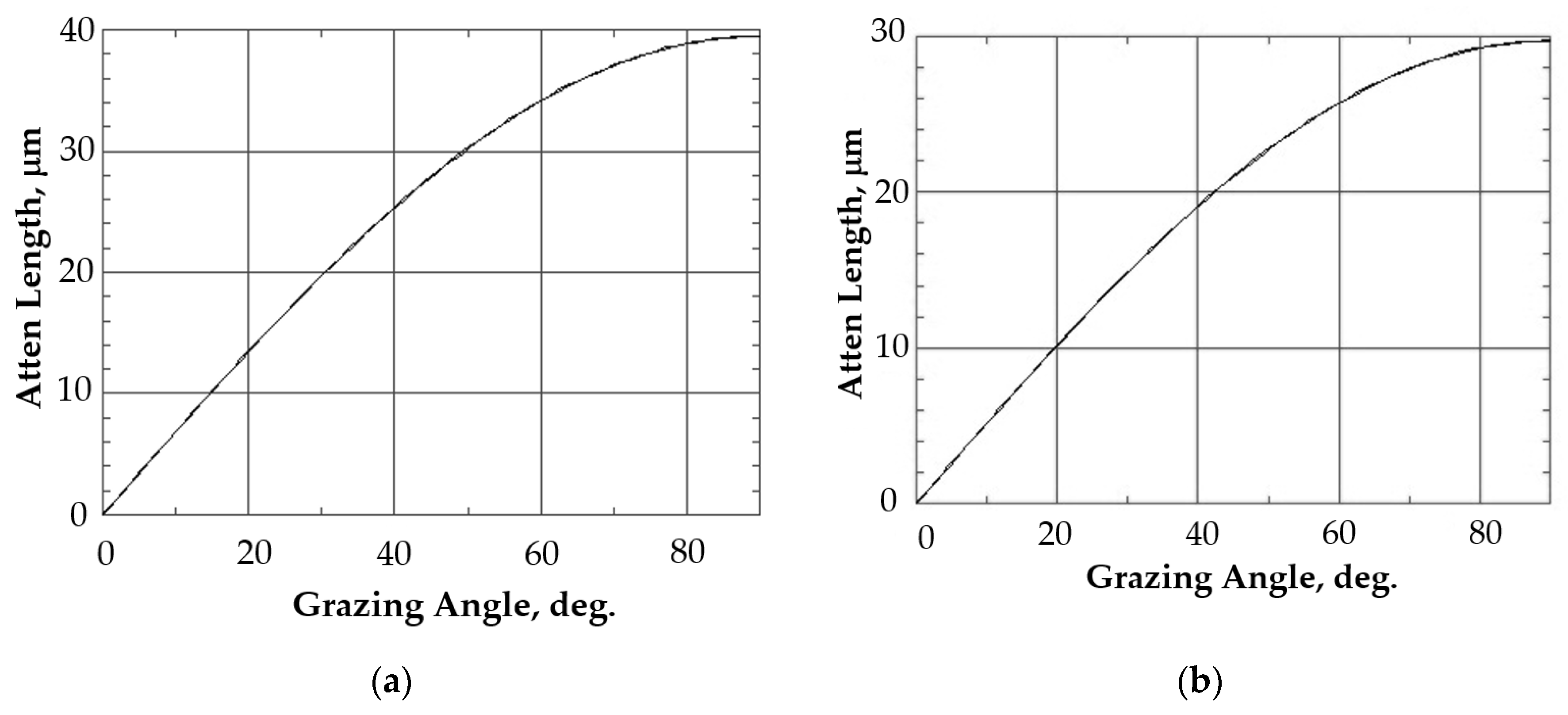
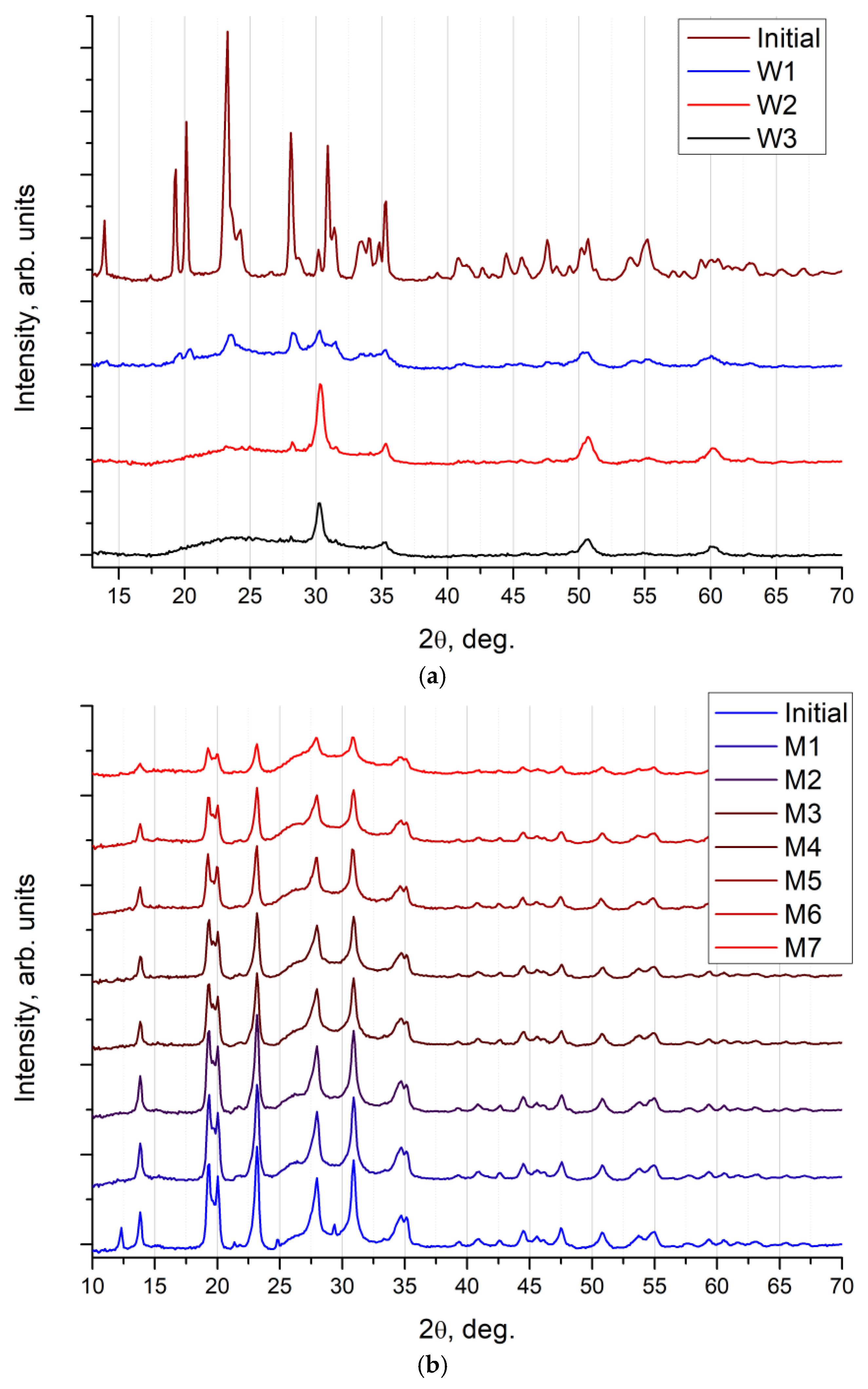

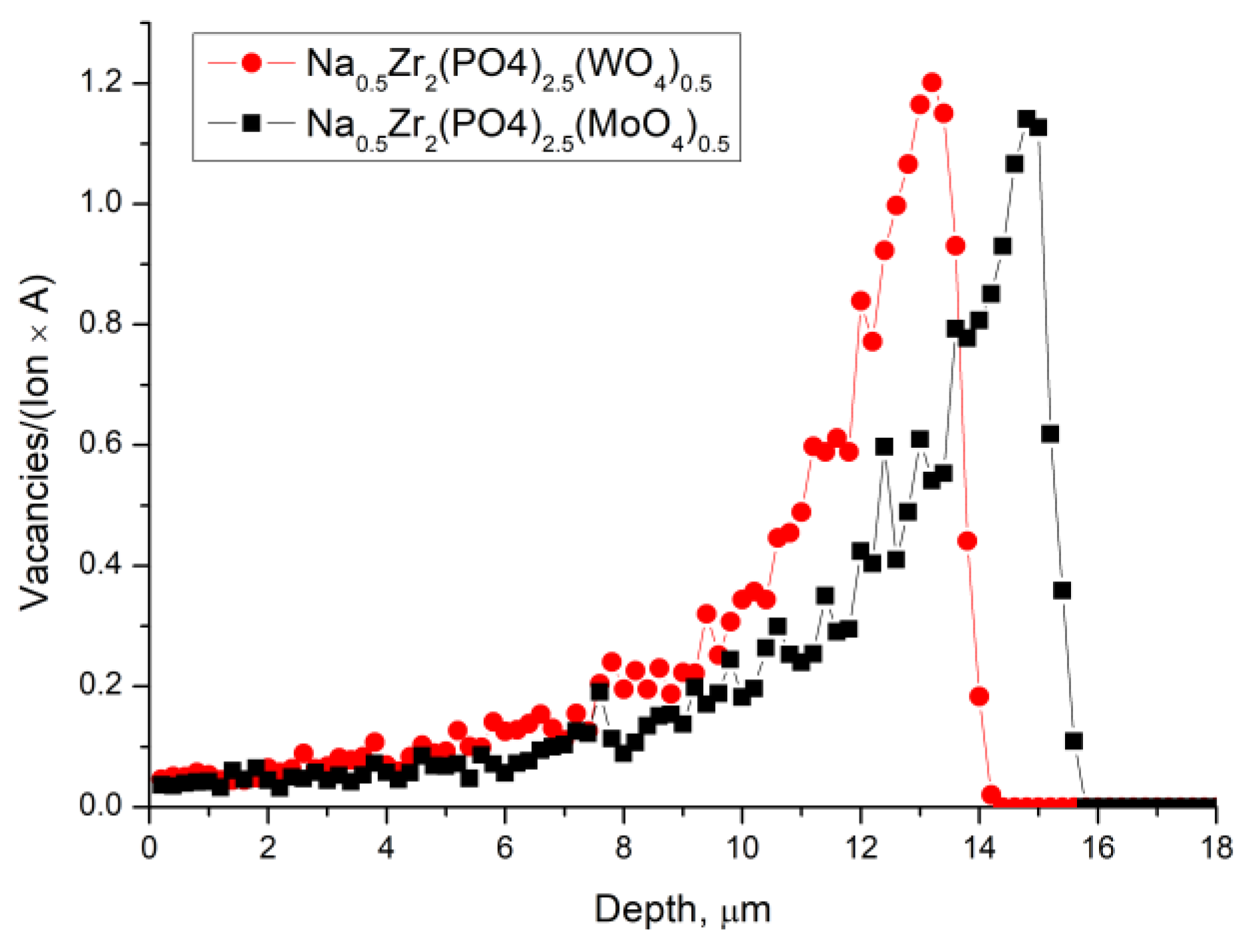
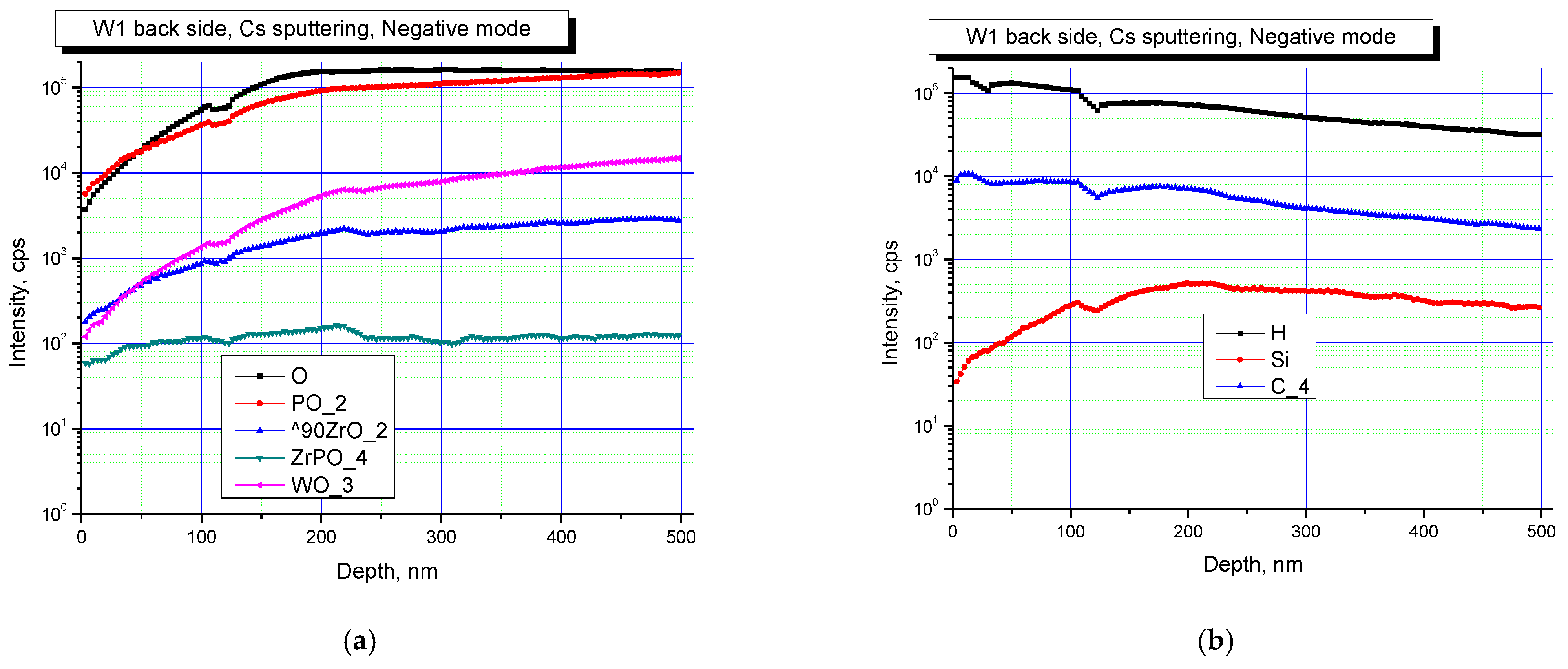
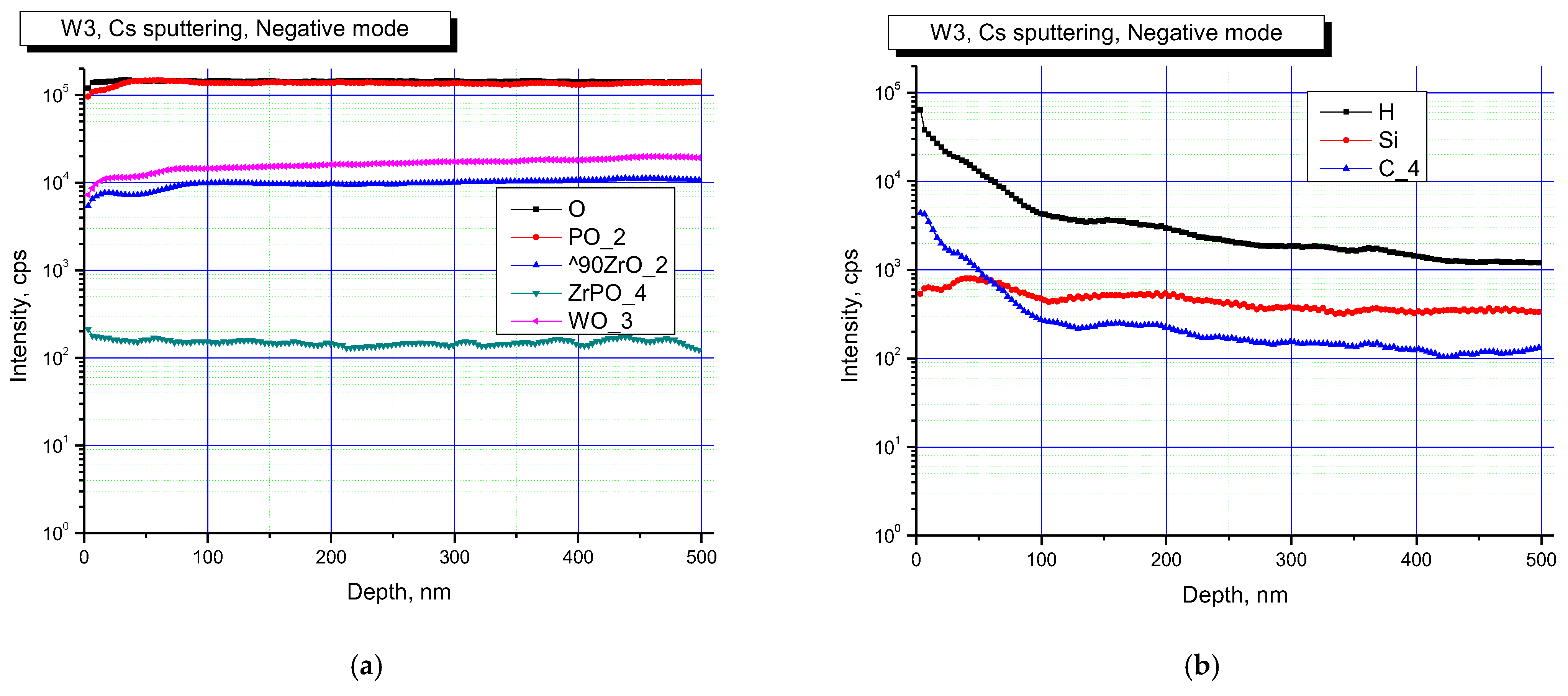

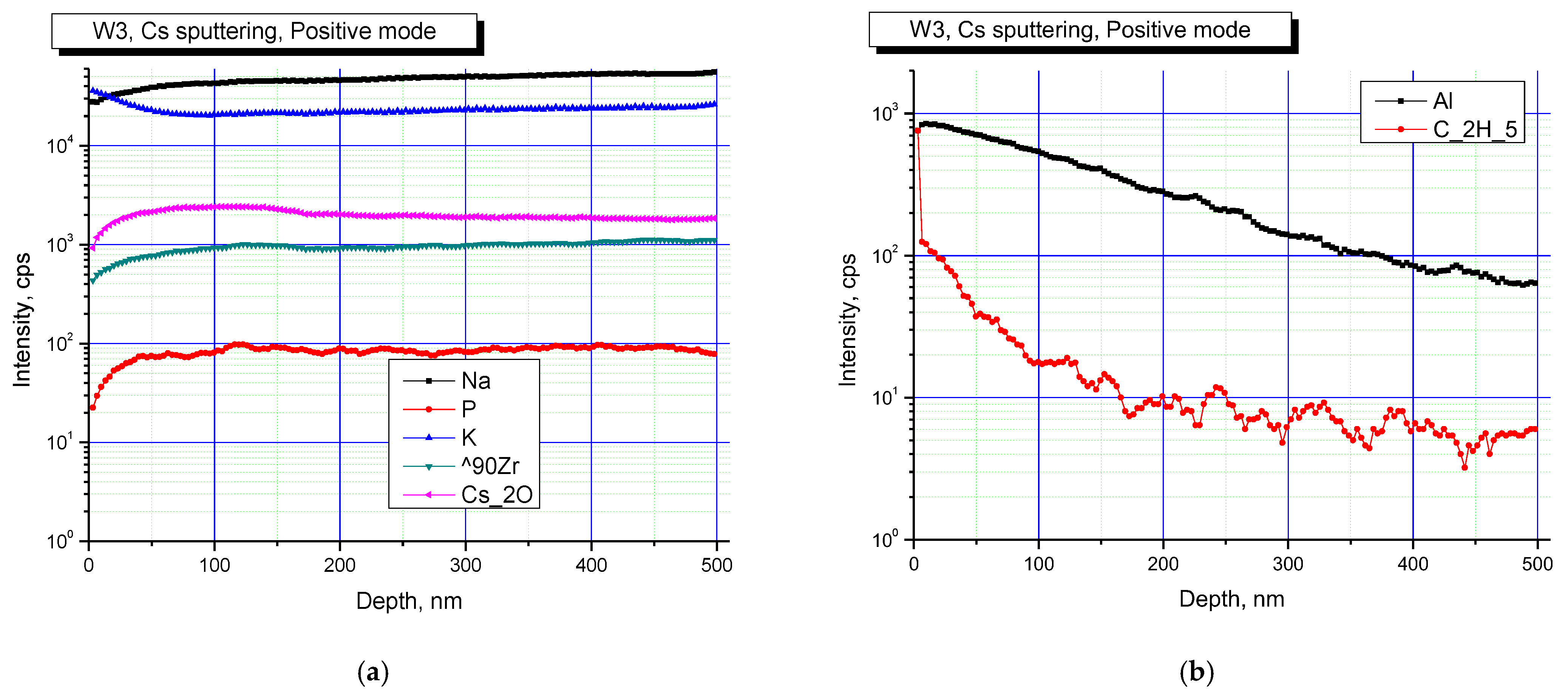
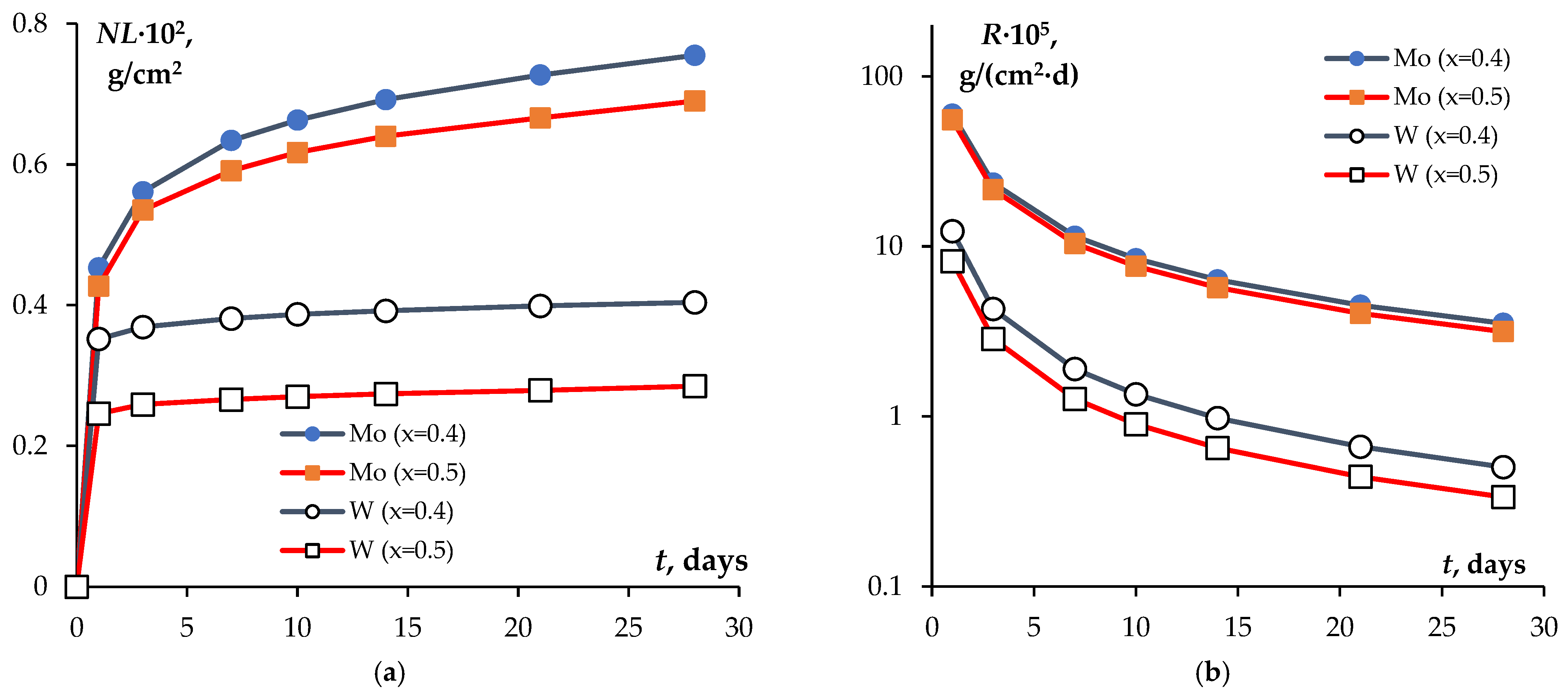
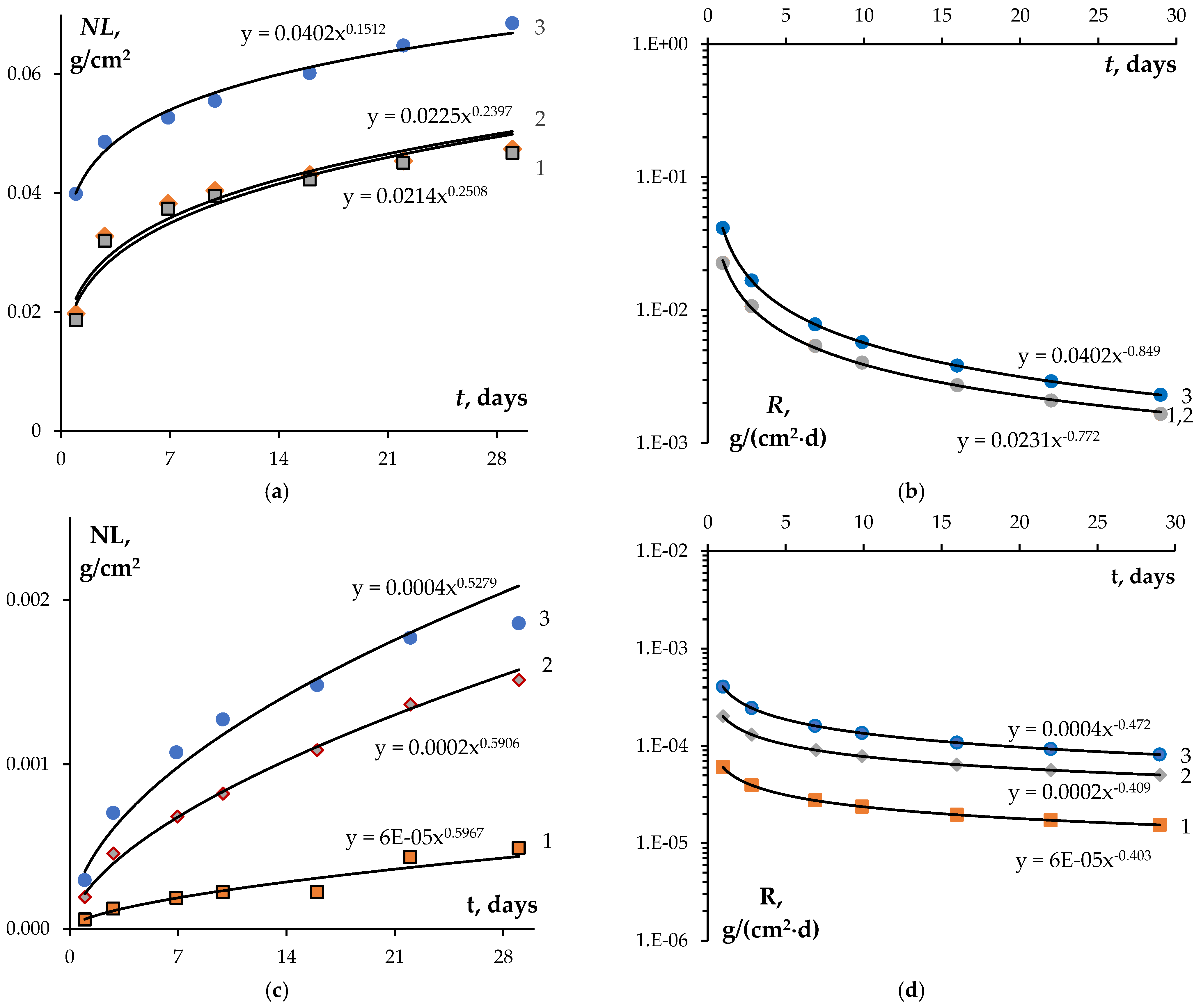
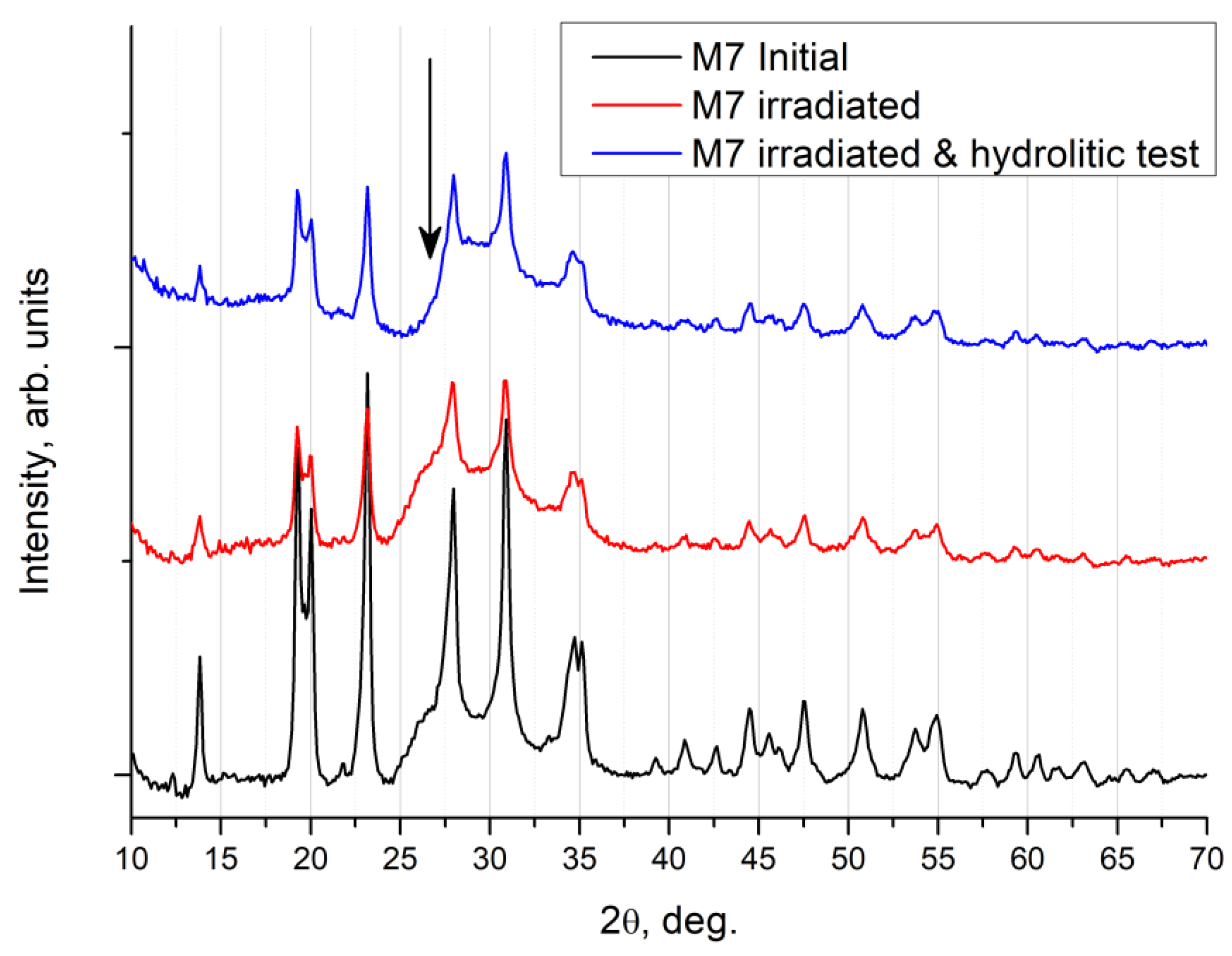

| x | t, Days | m·104, g | NL·102, g·cm−2 | R·105, g·cm−2·d−1 | |||
|---|---|---|---|---|---|---|---|
| Mo | W | Mo | W | Mo | W | ||
| 0.4 | 1 | 5.917 | 8.333 | 0.453 | 0.352 | 60.000 | 12.300 |
| 3 | 1.417 | 0.417 | 0.561 | 0.369 | 23.583 | 4.289 | |
| 7 | 0.958 | 0.275 | 0.634 | 0.381 | 11.477 | 1.903 | |
| 10 | 0.375 | 0.133 | 0.663 | 0.387 | 8.475 | 1.352 | |
| 14 | 0.375 | 0.125 | 0.692 | 0.392 | 6.367 | 0.979 | |
| 21 | 0.458 | 0.167 | 0.727 | 0.399 | 4.511 | 0.664 | |
| 28 | 0.375 | 0.125 | 0.755 | 0.404 | 3.532 | 0.504 | |
| 0.5 | 1 | 7.250 | 7.500 | 0.427 | 0.246 | 55.600 | 8.200 |
| 3 | 1.833 | 0.392 | 0.535 | 0.259 | 21.591 | 2.859 | |
| 7 | 0.958 | 0.208 | 0.591 | 0.266 | 10.410 | 1.269 | |
| 10 | 0.433 | 0.125 | 0.617 | 0.270 | 7.657 | 0.901 | |
| 14 | 0.400 | 0.108 | 0.640 | 0.274 | 5.731 | 0.653 | |
| 21 | 0.442 | 0.167 | 0.666 | 0.279 | 4.042 | 0.442 | |
| 28 | 0.408 | 0.167 | 0.690 | 0.285 | 3.156 | 0.336 | |
Disclaimer/Publisher’s Note: The statements, opinions and data contained in all publications are solely those of the individual author(s) and contributor(s) and not of MDPI and/or the editor(s). MDPI and/or the editor(s) disclaim responsibility for any injury to people or property resulting from any ideas, methods, instructions or products referred to in the content. |
© 2023 by the authors. Licensee MDPI, Basel, Switzerland. This article is an open access article distributed under the terms and conditions of the Creative Commons Attribution (CC BY) license (https://creativecommons.org/licenses/by/4.0/).
Share and Cite
Karaeva, M.E.; Savinykh, D.O.; Orlova, A.I.; Nokhrin, A.V.; Boldin, M.S.; Murashov, A.A.; Chuvil’deev, V.N.; Skuratov, V.A.; Issatov, A.T.; Yunin, P.A.; et al. (Na, Zr) and (Ca, Zr) Phosphate-Molybdates and Phosphate-Tungstates: II–Radiation Test and Hydrolytic Stability. Materials 2023, 16, 965. https://doi.org/10.3390/ma16030965
Karaeva ME, Savinykh DO, Orlova AI, Nokhrin AV, Boldin MS, Murashov AA, Chuvil’deev VN, Skuratov VA, Issatov AT, Yunin PA, et al. (Na, Zr) and (Ca, Zr) Phosphate-Molybdates and Phosphate-Tungstates: II–Radiation Test and Hydrolytic Stability. Materials. 2023; 16(3):965. https://doi.org/10.3390/ma16030965
Chicago/Turabian StyleKaraeva, M. E., D. O. Savinykh, A. I. Orlova, A. V. Nokhrin, M. S. Boldin, A. A. Murashov, V. N. Chuvil’deev, V. A. Skuratov, A. T. Issatov, P. A. Yunin, and et al. 2023. "(Na, Zr) and (Ca, Zr) Phosphate-Molybdates and Phosphate-Tungstates: II–Radiation Test and Hydrolytic Stability" Materials 16, no. 3: 965. https://doi.org/10.3390/ma16030965
APA StyleKaraeva, M. E., Savinykh, D. O., Orlova, A. I., Nokhrin, A. V., Boldin, M. S., Murashov, A. A., Chuvil’deev, V. N., Skuratov, V. A., Issatov, A. T., Yunin, P. A., Nazarov, A. A., Drozdov, M. N., Potanina, E. A., & Tabachkova, N. Y. (2023). (Na, Zr) and (Ca, Zr) Phosphate-Molybdates and Phosphate-Tungstates: II–Radiation Test and Hydrolytic Stability. Materials, 16(3), 965. https://doi.org/10.3390/ma16030965








